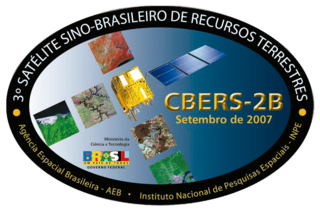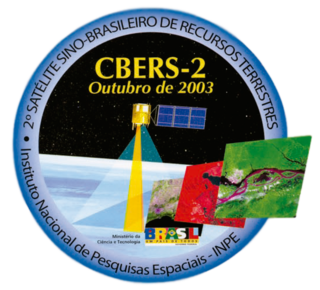
DigitalGlobe is an American commercial vendor of space imagery and geospatial content, and operator of civilian remote sensing spacecraft. The company went public on the New York Stock Exchange on 14 May 2009, selling 14.7 million shares at US$19.00 each to raise US$279 million in capital. On 5 October 2017, Maxar Technologies completed its acquisition of DigitalGlobe.

TIROS, or Television InfraRed Observation Satellite, is a series of early weather satellites launched by the United States, beginning with TIROS-1 in 1960. TIROS was the first satellite that was capable of remote sensing of the Earth, enabling scientists to view the Earth from a new perspective: space. The program, promoted by Harry Wexler, proved the usefulness of satellite weather observation, at a time when military reconnaissance satellites were secretly in development or use. TIROS demonstrated at that time that "the key to genius is often simplicity". TIROS is an acronym of "Television InfraRed Observation Satellite" and is also the plural of "tiro" which means "a young soldier, a beginner".

Cartosat-1 is a stereoscopic Earth observation satellite in a Sun-synchronous orbit, and the first one of the Cartosat series of satellites. The eleventh satellite of ISRO in Indian Remote Sensing Satellite (IRS) series. The satellite was launched by Indian Space Research Organisation and is operated by NTRO. Weighing around 1560 kg at launch, its applications will mainly be towards cartography in India.

The China–Brazil Earth Resources Satellite program (CBERS) is a technological cooperation program between Brazil and China which develops and operates Earth observation satellites.

China–Brazil Earth Resources Satellite 2B (CBERS-2B), also known as Ziyuan 1-2B, was a remote sensing satellite operated as part of the China–Brazil Earth Resources Satellite program between the Chinese Center for Resources Satellite Data and Application and Brazilian National Institute for Space Research. The third CBERS satellite to fly, it was launched by China in 2007 to replace CBERS-2.
VeneSat-1, also known as Simón Bolívar, was the first Venezuelan satellite. It was designed, built and launched by the CGWIC subsidiary of the China Aerospace Science and Technology Corporation. It was a communications satellite operating from a geosynchronous orbit. It was launched on a Chinese Long March 3B carrier rocket from Xichang Satellite Launch Center Launch Complex 2 on 29 October 2008 at 16:53 UTC.

Yaogan is the cover name used by the People's Republic of China to refer to its military reconnaissance satellites. Yaogan satellites are largely known to primarily support the People's Liberation Army's Strategic Support Force (PLASSF), formerly the Aerospace Reconnaissance Bureau of the Second Department of the General Staff. Yaogan satellites are the successor program to the Fanhui Shi Weixing (FSW) recoverable reconnaissance satellite program but, unlike its predecessor, includes a variety of classes utilizing various means of remote sensing such as optical reconnaissance, synthetic-aperture radar (SAR), and electronic intelligence (ELINT) for maritime surveillance. Yaogan satellites have been launched from the Taiyuan Satellite Launch Center (TSLC) in Shanxi province, the Jiuquan Satellite Launch Center (JSLC) in Inner Mongolia Autonomous Region, and the Xichang Satellite Launch Center (XSLC) in Sichuan province.

Oceansat-2 is the second Indian satellite built primarily for ocean applications. It was a part of the Indian Remote Sensing Programme satellite series. Oceansat-2 is an Indian satellite designed to provide service continuity for operational users of the Ocean Colour Monitor (OCM) instrument on Oceansat-1. It will also enhance the potential of applications in other areas. The OceanSat-2 mission was approved by the government of India on 16 July 2005.

China–Brazil Earth Resources Satellite 2 (CBERS-2), also known as Ziyuan I-02 or Ziyuan 1B, was a remote sensing satellite operated as part of the China–Brazil Earth Resources Satellite program between the Chinese Center for Resources Satellite Data and Application and Brazilian National Institute for Space Research. The second CBERS satellite to fly, it was launched by China in 2003 to replace CBERS-1.
The Pakistan Remote Sensing Satellite (PRSS), commercially known as Remote Sensing Satellite System (RSSS), is a dual-purpose Earth observational and optical satellite. Pakistan Remote Sensing Satellite-1 (PRSS-1) was launched from China's Jiuquan Satellite Centre on 9 July 2018.
IRS-1D is the seventh satellite in Indian Remote Sensing satellite series of Earth Observation satellites, built, launched and maintained by Indian Space Research Organisation (ISRO). The satellite has similar capabilities as that of ISRO's IRS-1C satellite with some improvements added for better imagery particularly in thematic mapping.
IRS-P2 was an Earth observation satellite launched under the National Natural Resources Management System (NNRMS) programme undertaken by Indian Space Research Organisation (ISRO). The objectives of the mission were to provide spaceborne capability to India in observing and managing natural resources and utilizing them in a productive manner. The satellite carried imaging multi-spectral radiometers on board for radio sensing of the resources.
The Cartosat is a series of Indian optical earth observation satellites built and operated by the Indian Space Research Organisation (ISRO). The Cartosat series is a part of the Indian Remote Sensing Program. They are used for Earth's resource management, defence services and monitoring.

The Bolivarian Agency for Space Activities is an agency of the Ministry of Science of Venezuela, responsible for developing and carrying out policies of the National Executive Venezuela regarding the use of the outer space.

China–Brazil Earth Resources Satellite 4 (CBERS-4), also known as Ziyuan I-04 or Ziyuan 1E, is a remote sensing satellite intended for operation as part of the China–Brazil Earth Resources Satellite program between the Chinese Center for Resources Satellite Data and Application and Brazilian National Institute for Space Research. The fifth CBERS satellite to fly, it was successfully launched on 7 December 2014. It replaces CBERS-3 which was lost in a launch failure in December 2013.

Gaofen is a series of Chinese high-resolution Earth imaging satellites launched as part of the China High-resolution Earth Observation System (CHEOS) program. CHEOS is a state-sponsored, civilian Earth-observation program used for agricultural, disaster, resource, and environmental monitoring. Proposed in 2006 and approved in 2010, the CHEOS program consists of the Gaofen series of space-based satellites, near-space and airborne systems such as airships and UAVs, ground systems that conduct data receipt, processing, calibration, and taskings, and a system of applications that fuse observation data with other sources to produce usable information and knowledge.
VRSS-2, also known as (Satellite) Antonio José de Sucre, is the second Venezuelan remote sensing satellite, and the third Venezuelan satellite after VRSS-1. It will be used to study Venezuelan territory and support planning, agriculture and disaster recovery. It was built and launched by the Chinese and has been named after Venezuelan revolutionary Antonio José de Sucre.
Wei Zhongquan was a Chinese satellite engineer who served as vice president and chief engineer of the Shanghai Satellite Engineering Institute. He was the chief designer of the Fengyun-2, China's first geostationary meteorological satellite, and the Yaogan-1, China's first remote sensing satellite.












